By Miguel Galindo
What HDMI cable do you need to play 4K vs HD? What HDMI cables can do 3D? What is HDMI 2.0? What is HDMI 1.4? This blog will answer these questions and give you valuable information on purchasing the right HDMI cable for your live video productions and system installations.
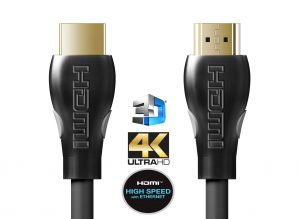
Ever since the introduction of the HDMI standard a decade ago, there have been many HDMI cable manufacturers and types on the market. Almost every year new versions of HDMI cable are released. These may sound familiar to you, like 1.0, 1.4, 2.0 etc.
Before we get into what each version does, its important to understand this all has to do with bandwidth. The higher the version, the more bandwidth supported. There are currently two main types of HDMI cable: Standard HDMI Cable and High Speed HDMI Cable. Standard cables only have enough bandwidth to push through 720p and 1080i video signals, and very importantly, not 1080p. In order to get create connectivity to 1080p and 4K video signals, you’ll need a High Speed HDMI cable. Manufacturers are required to specify whether their cables are Standard or High Speed. Any High Speed HDMI cable can transmit 4K video signals from your camera to a video mixer, recorder, or monitor. The same rules apply for going from 4K media players to your TV.
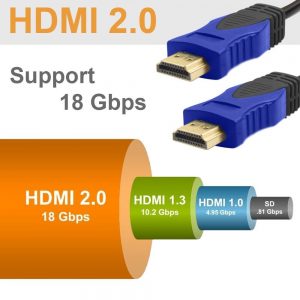
Now that you have figured out if you need standard or high speed, here are the formal differences for each HDMI version to narrow it down. Now, from the beginning to now, below is a historical journey through HDMI technology starting back in 2004. Here we go!
HDMI 1.0
The first and original HDMI v1.0 specification remains sufficient for most consumer purposes, but prosumers and professionals will need 1080p support and more. However, v1.0 is still solid and active in the world of tech with a backwards-compatible format transmits PCM audio, which can handle all of the high definition audio formats present today. The reason professionals will want newer HDMI standards for additional bandwidth provided by Deep Color (10- 12 and 16-bit color depths). It also does not support the new xvYCC color space. You may have pulled an old HDMI cable out of a box and tried it on your new camera or TV, and thrown it away because it went bad. It didn’t go bad, it just became obsolete.
HDMI 1.1
Not important, it just added support for DVD audio.
HDMI 1.2
A small but important addition that delivered a true one cable solution for all current high definition audio sources and took aim at the emerging VESA display port standard, which was better at the time. You most likely have a 1.2 HDMI cable somewhere in your home or studio.
HDMI 1.3
This update was a complete disaster. The industry could not agree on HD-DVD or Blu-Ray at the time, and couldn’t agree on priorities for HDMI either. Before 1.3, HD video could not be passed reliably over 50 feet. Then, when 1.3 had new but low quality HD audio formats were imposed in addition to ‘deep color’ the distance shrank to less than 50 feet. Many systems for video and tech companies failed, and is the main reason people think an HDMI signal cannot go more than 10 or 20 feet.
HDMI 1.4
The biggest update to HDMI ever, support was added for 4K, 3D, ethernet networking, bi-directional audio communications, and increased support for prosumer digital photography and computer devices. When HDMI works on your DSLR or very small form HD or 4K cameras, you can say, thank you 1.4!
Note: Support only for 4K x 2K resolution (3840 x 2160) at 24Hz, 25Hz, and 30Hz and 4096 x 2160 at 24Hz. No 50hz or 60hz, aka 50fps or 60fps support.
If you are doing 3D content for broadcast, you will want HDMI 1.4b cables.
HDMI 2.0
This is the most relevant update to the new products being released this year across the 4K camera manufacturers and supporting products. This increases bandwidth to 18Gbps, allowing Resolutions up to 4K @ 50p/60p (2160p, 4 times the clarity of 1080p/60 video resolution). Audio sample frequency was increased to 1536kHz and channels increased from 8 to 32. Last but not least, 4K and dual video can be supported on the same display for multiple users. It also includes support for 4k video—including dual video to the same display to multiple users. Audio is increased from 8 to 32 channels including simultaneous delivery of multichannel audio to a maximum of four users. Audio sample frequency is increased to 1536kHz.
And now we are in present day. Welcome back.
I’m sure by now you’ve determined which HDMI version you need. Great. Now, where to buy and how to get a good quality cable to is long?
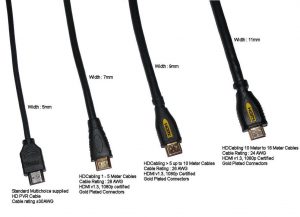
If you are in need of long HDMI cables (anything over 6 feet) you may want to look into RedMere technology. HDMI cables need thicker wires in order for the data signal to travel long distances reliably. Thicker wires can get bent or lose their flexibility easily, and if you are moving cameras or devices around, that is bad news. RedMere works by placing very small integrated circuits in long HDMI cables to boost and equalize the data. This allows manufacturers to make their wires thinner and longer than before, with less headaches for you.
Redmere cables have one main drawback – they are directional. That means you have to plug a transmitting end into your camera and a receiving end into your recorder, monitor or switcher. Traditional HDMI cables work in either direction, but Redmere has to be in one direction. If this is a deal breaker for you, you may have to stick with thicker cables.
When buying cables, more expensive is not always better. Many cables are looking to rip off prosumers with ‘gold plated’ placed all over the packaging or coat the cables with bold colors and nylon. Look into the specs, either it does the job you need it to, or it doesn’t and you have to look elsewhere.
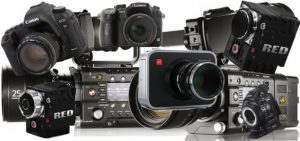
As far as where to buy cables, stick with where ever you typically buy electronics. If you are a new shopper for professional tech, many online retailers like Monoprice and Newegg are great for purchasing tech products, including cables. For your video productions, I do NOT recommend buying something from Amazon. It is a crowded space full of sellers offering low prices and poor customer service. Although the return policies are good, it is worth your time and money to purchase a HDMI cable somewhere else, purchase it once, and get it right sooner rather than later for your job.
If you have any additional questions or thoughts on HDMI, please comment in the blog and start a discussion here. I will jump in and answer with members of the community.

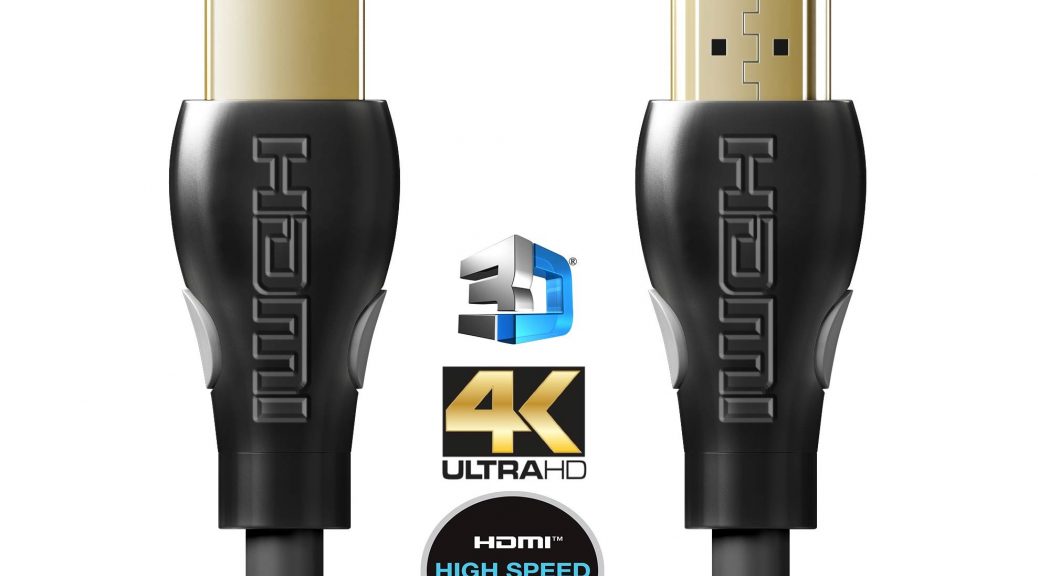
My hdmi cable is sending feed back into my microphone. I have a 9′ monitor run to my canon t7i and I keep getting a buzzing sound being sent from my hdmi cord. If i unplug the hdmi cord the buzz is gone. If i only use the internal mic and the monitor i get no feed back only when i plug the hdmi cord in i get a bad buzz.. i have tried different mic cords (3.5mm) and have switched out HDMI cords. I also tried pluging my monitor up in a different outlet that was grounded all whitch hasnt helped… anyone have any ideas?